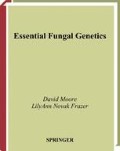Abstract
Although we discussed molecular markers in the Chapter 7, and thereby leaned toward physical analysis, the theme of our story so far has been the use of the classic approach of genetics: making an organized series of crosses and using gene segregations to deduce chromosome maps. Entirely conventional procedures can result in those chromosomal maps showing the location of genes and centromeres. Then, by using molecular markers, the telomeres of the chromosome, and as many other loci as we are willing to characterize and include in our crosses, can be mapped along the chromosomes of an organism. Large-scale, high-density linkage maps can be assembled in this way. A high-density linkage map is conventionally considered to be one with one gene or marker for each 1% recombination in the genome.
Access this chapter
Tax calculation will be finalised at checkout
Purchases are for personal use only
Preview
Unable to display preview. Download preview PDF.
Publications and Websites Worth a Visit
Aston, C. Mishra, B. & Schwartz, D.C. (1999). Optical mapping and its potential for large-scale sequencing projects. Trends in Biotechnology 17, 297–302.
Bennett, J.W. (1997). White paper: genomics for filamentous fungi. Fungal Genetics and Biology 21, 3–7.
Birren, B., Green, E.D., Klapholz, S., Myers, R.M. & Roskams, J. (1997). Genome Analysis: A Laboratory Manual. Vol. 1, Analyzing DNA. Vol. 2, Detecting Genes. Cold Spring Harbor Laboratory Press: Cold Spring Harbor, NY.
Cho, R.J. & Campbell, M.J. (2000). Transcription, genomes, function. Trends in Genetics 16, 409–415.
Delneri, D., Brancia, F.L. & Oliver, S.G. (2001). Towards a truly integrative biology through the functional genomics of yeast. Current Opinion in Biotechnology 12, 87–91.
Farman, M.L. (2001). Genome analysis in filamentous fungi. In Molecular and Cellular Biology of Filamentous Fungi (N.J. Talbot, ed.), pp. 91–117. Oxford University Press: Oxford, U.K.
Horiike, T., Hamada, K., Kanaya, S. & Shinozawa, T. (2001). Origin of eukaryotic cell nuclei by symbiosis of Archaea in Bacteria is revealed by homology-hit analysis. Nature Cell Biology 3, 210–214.
Jansen, R.C. & Nap, J.-P. (2001). Genetical genomics: the added value from segregation. Trends in Genetics 17, 388–391.
Kupfer, D.M., Reece, CA., Clifton, S.W., Roe, B.A. & Prade, R.A. (1997). Multicellular ascomycetous fungal genomes contain more than 8000 genes. Fungal Genetics and Biology 21, 364–372.
Murray, A.W. (2000). Whither genomics? Genome Biology 1, comment003.1-003.6. The journal Nature operates a Genome Gateway, which is intended to be a comprehensive web resource devoted to genomics that includes original research papers, a news service, and a set of links to the most useful and informative genomics sites on the web. Access is free at http://www.nature.com/genomics/intro.html.
Nitta, N, Farman, M.L. & Leong, S.A. (1997). Genome organization of Magnaporthe grisea: integration of genetics maps, clustering of transposable elements and identification of genome duplications and rearrangements. Theoretical and Applied Genetics 5, 20–32.
Pandolfo, M. (1999). Molecular pathogenesis of Friedreich Ataxia. Archives of Neurology 56, 1201–1208.
Peterson, S.N. & Fraser, CM. (2001). The complexity of simplicity. Genome Biology 2, comment2002.1-2002.8. The electronic version of this article can be found online at http://genomebiology.com/2001/2/2/comment/2002.
Prade, R.A. (2000). The reliability of the Aspergillus nidulans physical map. Fungal Genetics and Biology 29, 175–185.
Raamsdonk, L.M., Teusink, B., Broadhurst, D., Zhang, N, Hayes, A., Walsh, M.C & Berden, J.A. (2001). A functional genomics strategy that uses metabolome data to reveal the phenotype of silent mutations. Nature Biotechnology 19, 45–50.
Sharman, A. (2001). The many uses of a genome sequence. Genome Biology 2, reports 4013.1-4013.4. The electronic version of this article can be found online at http://genomebiology.com/2001/2/6/reports/4013.
Spurr, N.K., Young, B.D. & Bryant, S.P. (1998). ICRF Handbook of Genome Analysis (in two volumes). Blackwell Science Ltd: Oxford, U.K.
Tait, E., Simon, M.C., King, S., Brown, A.J., Gow, N.A.R. & Shaw, DJ. (1997). A Candida albicans genome project: cosmid contigs, physical mapping, and gene isolation. Fungal Genetics and Biology 21, 308–314.
Thompson, A., Lucchini, S. & Hinton, J.C.D. (2001). It’s easy to build your own microarrayer! Trends in Microbiology 9, 154–156.
Washburn, M.P. & Yates, J.R. III (2000). Analysis of the microbial proteome. Current Opinion in Microbiology 3, 292–297.
Zhu, H., Choi, S., Johnson, A.K., Wing, R.A. & Dean, R.A. (1997). A large-insert (130 kbp) bacterial artificial chromosome library of the rice blast fungus Magnaporthe grisea: genome analysis, contig assembly, and gene cloning. Fungal Genetics and Biology 21, 337–347.
Historical Publications Worth Knowing About
Bell, G.I., DeGennaro, L.J., Gelfand, D.H., Bishop, R.J., Valenzuela, P. & Rutter, WJ. (1977). Ribosomal RNA genes of Saccharomyces cerevisiae. I. Physical map of the repeating unit and location of the regions coding for 5S, 5.8S, 18S and 25S ribosomal RNAs. Journal of Biological Chemistry 252, 8118–8125.
Broda, P., Oliver, S.G. & Sims, REG. (1993). The Eukaryotic Genome. Cambridge University Press: Cambridge, U.K.
Metzenberg, R.L., Stevens, J.N., Selker, E.U. & Morzycka-Wroblewska, E. (1985). Identification and chromosomal distribution of 5 S rRNA genes in Neurospora crassa. Proceedings of the National Academy of Sciences of the United States of America 82, 2067–2071.
Schwartz, D.C., Li, X., Hernandez, L.I., Ramnarain, S.P., Huff, E.J. & Wang, Y.-K. (1993). Ordered restriction maps of Saccharomyces cerevisiae chromosomes constructed by optical mapping. Science 262, 110–114.
Rights and permissions
Copyright information
© 2002 Springer-Verlag New York, Inc.
About this chapter
Cite this chapter
(2002). Genes to Genomics: Mapping the Fungal Genome. In: Essential Fungal Genetics. Springer, New York, NY. https://doi.org/10.1007/978-0-387-22457-2_8
Download citation
DOI: https://doi.org/10.1007/978-0-387-22457-2_8
Publisher Name: Springer, New York, NY
Print ISBN: 978-0-387-95367-0
Online ISBN: 978-0-387-22457-2
eBook Packages: Springer Book Archive

